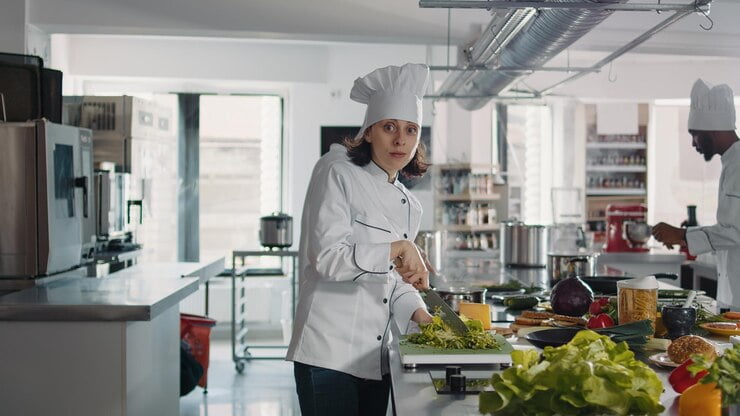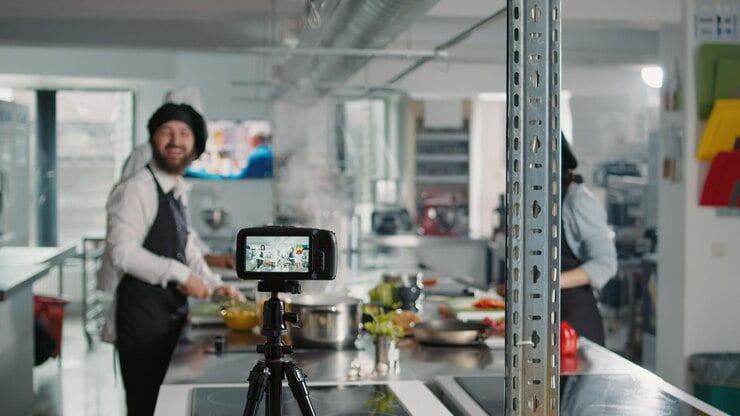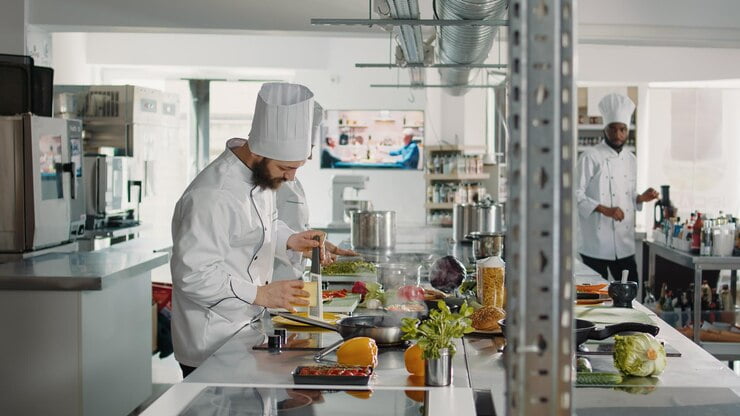Craving that juicy burger from your favorite blockbuster? Think again! Movie meals are more illusion than reality, spun by a hidden army of culinary wizards called film food stylists. They wield glue-like glaze, whip mashed potatoes into ice cream, and make wilted lettuce sing.
Prepare to have your mind (and taste buds) blown as we delve into the delicious deception of film food, revealing the shocking secrets that make those screen feasts so mouthwatering. You won’t believe what goes into creating those culinary masterpieces – or how much of it you’ve actually been swallowing with your popcorn!
The Delicious Deception: Confessions of a Film Food Stylist.
Alright, cinephiles, gather ’round! Let’s peel back the curtain on a secret weapon of the silver screen: the film food stylist. We’re the magicians behind the meal, conjuring culinary illusions that make your mouth water and your heart ache (yes, even that wilted salad in “Titanic”).
In my 20 years in this delectable (and slightly deranged) profession, I’ve learned a thing or two about crafting edible narratives. So, grab a metaphorical popcorn bucket, and let me spill the secrets of making food the ultimate scene-stealer.
I. More Than Just Eye Candy: Food as Storytelling Alchemy
Forget bland props and cardboard pizza. A film food stylist’s canvas is an edible one, where every morsel speaks volumes. Forget bland props and cardboard pizza. Food tells stories. It reflects culture, fuels emotions, and binds characters together. Remember the glistening roast chicken in “Julie & Julia”? That wasn’t just dinner; it was Julia’s passion, her connection to her heritage, and ultimately, her victory.

II. From Script to Supper: The Unsung Choreography of a Food Stylist
Think film magic happens overnight? Not this culinary caper! My days are a whirlwind of pre-production. Imagine me, script in hand, dissecting every meal mentioned. I’m a historical detective, digging up period-accurate recipes. I’m a budget Houdini, conjuring feasts with supermarket sleight-of-hand. And, oh, the collaborations! With directors, prop masters, and even costume designers (because, yes, the food needs the right outfit too!).
A Peek into My Toolbox:
- Edible MacGyver: Ever replaced a missing cherry with a strategically placed red M&M? Just another day at the (film) office.
- Master of Disguise: That “freshly baked” pie? Probably pre-baked and strategically aged to look picture-perfect. We work miracles, people!
- Time-Taming Alchemist: Keeping food camera-ready for multiple takes means battling entropy with every sprinkle, spritz, and strategic ice pack.
Next up: On-set shenanigans and the art of making fake food look (and sometimes taste) real. Stay tuned, cinefoodies! Your cravings are about to get seriously satisfied.
This is just the opening course, folks. Stay tuned for Part II, where I’ll unveil the on-set chaos, the secrets of making movie meals irresistible, and maybe even share a recipe or two. Trust me, the world of film food styling is as juicy and complex as any Hollywood drama. And I’m just the chef spilling the tea (or should I say, the gravy?).
Feel free to leave your culinary curiosities in the comments below! And remember, next time you watch a film, pay attention to the food. It’s not just props; it’s a silent symphony of storytelling, ready to tantalize your taste buds and tickle your emotions. Bon appétit!
The Burning (But Delicious) Challenges of Film Food Styling.
Alright, folks, let’s get real. Film food styling ain’t all sunshine and sprinkles. It’s a pressure cooker, baby, and the heat comes in all shapes and sizes. Here’s a taste of the challenges that keep me on my toes (and sometimes have me reaching for the antacids):
1. The Clock’s a Tyrant: Deadlines are tighter than a sous vide bag. Imagine whipping up a picture-perfect Thanksgiving feast in 15 minutes, with the director breathing down your neck and the leading lady demanding gluten-free stuffing (stat!). Multitasking becomes an Olympic sport, and creativity thrives under fire.

2. Budgetary Balancing Act: Turning cinematic dreams into edible realities on a shoestring budget is like making soufflé with stale breadcrumbs. Resourcefulness becomes your middle name. You learn to stretch a wilted lettuce leaf into a verdant oasis, and that day-old roast chicken? BAM! Instant pulled pork masterpiece with some strategic BBQ sauce magic.
3. Mother Nature’s Mayhem: Film sets are battlegrounds against the elements. A rogue gust of wind can send your meticulously crafted cake tumbling and don’t even get me started on the tyranny of wilting greens under studio lights. It’s a constant dance with ice packs, humidity shields, and enough plastic wrap to conquer a supermarket.
4. The Picky Palates of Perfection: Actors, bless their artistic souls, can be culinary enigmas. One leading man wants his steak “bloody rare, but not too pink.” Another insists on organic, locally sourced kale chips between takes (while simultaneously munching on gummy bears). Keeping everyone happy (and their tummies satisfied) is a delicate negotiation.
But here’s the secret sauce: these challenges are what make the job so damn thrilling. They force you to think on your feet, improvise like a jazz musician, and channel your inner culinary MacGyver. When you pull off a seemingly impossible food feat, the applause (and the grateful sighs from the director) are sweeter than any dessert.
Masters of the Edible Canvas: Spotlight on Renowned Film Food Stylists.
Now, let’s give some props to the rockstars of our realm! These are the food stylists who’ve elevated movie meals to an art form:
- Susan Turner: The mastermind behind the mouthwatering feasts in “Eat Pray Love” and “Julie & Julia,” Turner’s meticulous research and historical accuracy bring culinary authenticity to the screen.
- Charles Phoenix: This culinary chameleon can whip up anything from a Depression-era stew in “Seabiscuit” to a futuristic sushi platter in “Blade Runner 2049.” His versatility and playful creativity are an inspiration.
- Donal Logue: Yes, the actor! When not battling zombies, Logue moonlights as a food stylist, bringing his passion for fresh, seasonal ingredients to projects like “Gotham” and “Ozark.” He’s proof that anyone with a discerning palate can be a maestro of movie meals.
These are just a few of the incredible talents shaping the landscape of film food styling. Each artist brings their own unique vision and skillset to the table, proving that a well-crafted dish can be just as powerful as a poignant monologue.
So, there you have it, folks! A glimpse into the delectable world of film food styling, where challenges ignite creativity, budgets become playgrounds, and every meal tells a story. Remember, next time you’re captivated by a cinematic feast, raise a glass (or fork) to the unseen artists who spin culinary magic behind the scenes. We’re the silent storytellers, the edible illusionists, and we wouldn’t have it any other way.
V. A Glimpse into the Future of Film Food Styling: Where Technology Meets Taste Buds
As the film industry evolves, so does the art of food styling. Here’s a sneak peek into the tantalizing trends shaping the future of edible storytelling:
1. 3D Printing Food, No Kidding: Imagine printing a perfectly textured steak or a gravity-defying cake right on set! 3D food printing is slowly entering the film world, offering endless possibilities for creating visually stunning and even customizable food scenes.
2. Sustainable Cinema Cuisine: The push for eco-conscious filmmaking is extending to food styling. Stylists are embracing local, seasonal ingredients, reducing food waste, and composting on set. It’s not just about looking good; it’s about doing good, too.

3. Augmented Reality: Enhancing the Food Experience: AR has the potential to revolutionize how audiences experience food in film. Imagine scanning a QR code during a movie and seeing the recipe for that mouthwatering pasta dish pop up on your phone!
4. Food as a Multi-Sensory Experience: Filmmakers are exploring ways to engage all of our senses through food. Think about immersive soundscapes that amplify the crunch of a crispy chip or the sizzle of a juicy burger. Food styling is becoming a multi-sensory art form.
## VI. A Final Course: The Rewarding Recipe for a Film Food Stylist Career
So, do you have a passion for food, a knack for visual storytelling, and a love of working behind the scenes? Then a career in film food styling might just be your perfect recipe for success!
Here’s a taste of what it takes to make it in this delectable field:
- Culinary Expertise: A strong foundation in cooking techniques, food science, and visual presentation is essential.
- Artistic Flair: A keen eye for detail, a sense of visual harmony, and the ability to create edible masterpieces are key.
- Collaboration Skills: Food stylists work closely with directors, actors, props teams, and cinematographers, making teamwork a must-have ingredient.
- Adaptability and Problem-Solving: Expect the unexpected on set! Food stylists must be quick-thinking, adaptable, and resourceful to overcome any culinary curveballs.
A Final Course: The Rewarding Recipe for a Film Food Stylist Career**
- Resourcefulness and Budget Savvy: Turning culinary dreams into edible realities within budget constraints is a constant challenge. Think MacGyver meets Martha Stewart!
- Passion and Persistence: This is a competitive field, but with dedication, continuous learning, and a portfolio that showcases your unique style, you can rise to the top.
The Rewards? Oh, they’re enough to make your taste buds sing!
- Witnessing your creations come to life on the big screen: It’s an incredible feeling to see your meticulously crafted meal steal the scene in a major motion picture.
- Collaborating with talented artists: From visionary directors to award-winning actors, you’ll be surrounded by creative minds who inspire and push you to new heights.
- The constant challenge and thrill of the unexpected: Every day is a new culinary adventure, where quick thinking and resourcefulness are your secret weapons.
- Making a difference through storytelling: Food can evoke emotions, bridge cultures, and spark important conversations. As a film food stylist, you play a role in shaping cinematic narratives that resonate with audiences worldwide.

And remember, the journey is just as delicious as the destination. Building your network, attending industry events, and showcasing your work online are all crucial steps in building your reputation and landing your dream projects.
VII. Bon Appétit, Future Film Food Stylists!
Now, cinephiles and culinary comrades, I leave you with this: the world of film food styling is a vibrant, dynamic space overflowing with creativity, challenges, and rewards. If you have the passion, the skills, and the insatiable appetite for both food and filmmaking, then grab your chef’s hat, and your camera, and dive into this delectable adventure.
Remember, every great meal starts with a single delicious idea. So, dream big, experiment boldly, and never stop pushing the boundaries of what’s possible on the edible canvas of film. The silver screen awaits your culinary artistry!
A Taste of Behind-the-Scenes Secrets: Spilling the Beans (and Berries) from My Food Styling Kit
Alright, folks, let’s get down to the nitty-gritty of food-styling secrets! I’m about to dish out some insider tips and tricks that’ll make you look at those cinematic feasts with a whole new level of appreciation (and maybe a touch of skepticism).
Here’s a peek into my culinary bag of tricks:
- Glue, Not Gravy: Ever wonder how that roast chicken looks so perfectly glistening? It might have a secret coating of hairspray or glycerin. And those tempting syrup drizzles on pancakes? Often made with Elmer’s glue!
- Ice Cream Imposters: That scoop of vanilla melting seductively under the studio lights? It’s probably mashed potatoes whipped with food coloring. And those vibrant sorbets? Usually sculpted from a mixture of shortening and powdered sugar.
- Spray-On Freshness: Wilted lettuce, dull berries, and droopy herbs are no match for a skilled food stylist armed with a water mister and a spritz of glycerin. We can revive even the most stubborn produce into camera-ready freshness.
- Strategic Splatters and Drizzles: A perfectly placed coffee stain on a script, a dollop of ketchup artfully smeared on a burger—these seemingly spontaneous moments are often carefully orchestrated with syringes and paintbrushes.
- The Magic of Sound: Crunchy chips, sizzling bacon, and crackling bread are often enhanced with Foley artists who create these satisfying sounds during post-production. Food styling is a multi-sensory experience, even if you can’t taste it through the screen.

IX. Beyond the Silver Screen: The Art of Food Styling in Other Visual Media
Think film is the only place where food stylists work their magic? Think again! Our culinary wizardry extends to various visual media, from commercial photography to social media content.
Here are some other tasty avenues for food stylists:
- Commercials: Making those burgers look juicy and irresistible on TV? That’s our handiwork.
- Cookbooks and Magazines: Those drool-worthy photos in your favorite recipes? Styled to perfection to make you want to dive right in.
- Product Packaging: Ever notice how breakfast cereal always looks perfectly crunchy and colorful on the box? Thank a food stylist for that visual appeal.
- Social Media: Influencers and brands are increasingly relying on food stylists to create eye-catching content that makes their dishes pop on Instagram, TikTok, and beyond.
The world of food styling is vast and ever-evolving. It’s a delicious blend of art, science, and culinary creativity that brings stories to life and makes our mouths water, no matter the screen size.
Unwrapping the Future: Innovative Food Styling Techniques on the Horizon.
The delectable world of film food styling is never content to sit on its laurels. As technology and culinary imagination continue to evolve, exciting new techniques are on the horizon, ready to tantalize both our eyes and our taste buds. Here’s a sneak peek at some potential game-changers:
- Bioprinting the Future: Imagine bioprinting realistic, edible textures and even meat substitutes directly on set! This game-changing technology could revolutionize how we create visually stunning and ethically sourced food scenes.
- Interactive Dining with AR/VR: Forget passive movie watching! Augmented and virtual reality could immerse viewers in the sensory experience of food, allowing them to interact with dishes, smell the spices, and even virtually taste the flavors.
- Taste the Screen with Digital Gastronomy: Imagine sensors in your movie theater seat translating on-screen flavors into real-time taste sensations! This mind-blowing innovation could blur the lines between reality and cinematic experiences, truly making you taste the food alongside the characters.
XI. A Bite of Inspiration: Final Words for the Aspiring Food Stylist.
Whether you’re a seasoned chef eyeing a new culinary adventure or a fresh-faced foodie with a camera and a dream, the world of film food styling awaits you with open arms (and empty plates!). Remember these parting words as you embark on your delectable journey:
- Fuel your passion: This field thrives on creativity and enthusiasm. Keep exploring, experimenting, and pushing the boundaries of your culinary imagination.
- Practice makes perfect: Hone your skills in the kitchen, study food photography, and learn the tricks of the trade from established stylists.
- Build your network: Collaborate with other creatives, attend industry events, and showcase your work online. The more you connect, the further you’ll climb in this vibrant community.
- Never stop learning: Food trends, technology, and filmmaking techniques are constantly evolving. Stay curious, embrace new challenges, and keep learning throughout your career.
Most importantly, remember that food is more than just sustenance; it’s a powerful storytelling tool, a cultural language, and a source of endless creative possibilities. So, grab your whisk, your imagination, and a healthy dose of passion, and step into the vibrant world of film food styling. Remember, it’s not just about making food look good; it’s about making it tell a story that lingers long after the credits roll.
Now, go forth and make the cinema delicious!

I am a highly experienced film and media person who has a great deal to offer to like-minded individuals. Currently working on several exciting projects, I am a film and media practitioner for over a decade. I have achieved a great deal of success in my professional career.





